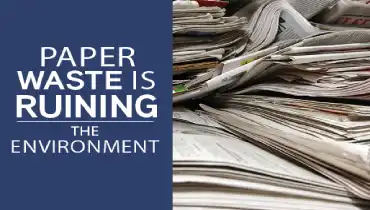
Americans go through 15 billion rolls of toilet paper every year. That’s enough to wrap around the globe 40 times! And that’s just the beginning of America’s love affair with paper products. We may be going digital at work – sending e-mails instead of letters and quick group notifications in place of paper memos – but at home, we go through toilet paper, paper towels, paper plates, paper napkins, newspaper, wrapping paper, and other paper products at an alarming rate.
If you’re wondering how much paper is wasted each year, learn more about paper waste statistics and how you can do your part to reduce the amount of paper in landfill.
Paper Waste Statistics
- An average of 300 million tons of paper is produced each year. This means, as you’ve been reading this blog, another 285 tons of paper have gone into production.
- The average American consumes more than 700 pounds of paper each year.
- Paper accounts for 25 percent of waste in landfill and 33 percent of municipal waste.
- About 68 million trees are cut down each year to produce paper and paper products. If you don’t recycle the paper you use, it all ends up in the landfill.
What Happens to Toilet Paper When You Flush It?
When you throw toilet paper or paper towels in the trash, this waste ends up in the landfill, but what about the toilet paper you flush? As you can imagine, used toilet paper isn’t something you want to recycle. It’s designed to disintegrate in water, which is important to prevent your plumbing from clogging, and also helps with the water treatment process.
At first glance, you may assume this means there’s nothing you can do to lessen your toilet paper consumption. However, aside from using fewer sheets, Americans could decrease our demand for toilet paper if we followed the example of Europeans and used bidets.
How Recycling Reduces Paper Waste in the Landfill
While energy and water are required to make recycled paper, the process doesn’t involve any new wood. In brief, here’s how recycled paper products are made:
- Used paper is shredded, mixed with water and chemicals, and heated until it forms a pulp.
- The pulp is spun to remove impurities.
- Purified pulp is sprayed onto a conveyer belt where the paper fibers start bonding together.
- Heated metal rollers dry the paper, which is spooled onto large rolls, ready to be made into recycled paper products.
When everyone recycles, it creates the opportunity to buy recycled paper products. Be a conscious consumer and look for “100 percent post-consumer recycled” products to complete this crucial final step in the recycling process.
Skip Paper Altogether
It may seem that when you choose reusable dishes or cloth napkins, all you’re doing is swapping out paper waste for more water to wash these items. However, it actually takes more water than you might think to make paper. By replacing one ton of paper plates and napkins with reusable dishes or cloth napkins, you save 7,000 gallons of water, not to mention 17 trees and 700 gallons of oil.
Fun Ways to Reuse Paper Towels and Toilet Paper Rolls
There are more ways to recycle paper than simply tossing it in the recycling bin. You can also repurpose empty toilet paper and paper towel rolls into fun crafts you do with your kids. We have a whole Rolls Repurposed Series to inspire you!
If you’re interested in more plumbing or paper-related tips and tricks, please contact Mr. Rooter® Plumbing today.
Sign up for the monthly My Home Life magazine for more great tips.

